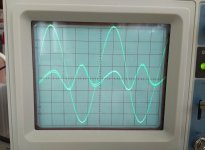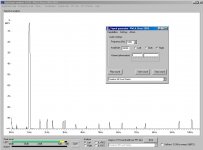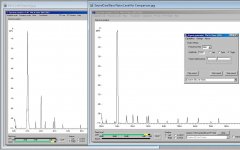I did some more tests this afternoon. I found I had already made a new cable (and forgotten about it). Provided the earth connection is kept out of the picture for both output and input the loopback at least looks good. When lifting the output shield to the balanced to SE converter and taking the output of that to tip and ring of the input with no shield the results are on par (or in fact better) with those when passed through the SE to balanced comverter.
If the output shield is connected to common however then the results are no better than when using straight mono loopback cable.
Attached is the result with only the balanced to SE converter and the rca to TRS cable on the input.
I can try a test with just tip and ring for both output and input through an audio device and see how that goes. certainly loopback with just tip/ring and no sleeve gives comparible results to the bal to SE loopback posted in this post.
Tony.
Looking at the loopback FFT I see that H2 is about -128 while H3 is -118db a difference of around 10db. Does this mean the soundcard is producing these harmonics, and if so wont the harmonics we measure for say a preamp be skewed likewise?
Tks nash
I guess I could put it on a card and pay off in week or two...
That’s a slippery slope. I know... I’m on it right now.
What is zenmod’s M25 kit?
That’s a slippery slope. I know... I’m on it right now.
What is zenmod’s M25 kit?
Here it is:
Babelfish M25 , AKA M2 on steroids , AKA M2-XA25 bstrd - kit packages
(I'm also on that slippery slope...)
That’s a slippery slope. I know... I’m on it right now.
What is zenmod’s M25 kit?
Sorry, here's some slippery slope for you:
Babelfish M25 , AKA M2 on steroids , AKA M2-XA25 bstrd
Russellc
Here it is:
Babelfish M25 , AKA M2 on steroids , AKA M2-XA25 bstrd - kit packages
(I'm also on that slippery slope...)
Whoops...guess I should have read the next post before cluttering...Anywho, that's it.
Russellc
Looking at the loopback FFT I see that H2 is about -128 while H3 is -118db a difference of around 10db. Does this mean the soundcard is producing these harmonics, and if so wont the harmonics we measure for say a preamp be skewed likewise?
Tks nash
Really want to see this one answered! We are well on the way to flushing this out. Looking at everyones results, I still have no idea what is H2 or what is H3.
Russellc
I still have no idea what is H2 or what is H3.
I'm assuming you are putting a signal through it generated by ARTA,
I can't confirm if that level is normal with your setup (I haven't played with my 2i2 yet, waiting for delivery of DRV134, adaptors and cables - cheaper to buy than make).
A pure sine wave has no harmonics. the ARTA signal being software generated, it's PC/Laptop quality dependant, if it's dropping bits, H2 to Hn will increase.
What noise floor do you get if you short the input to ground?
You could try an external source to see if you get different results, test tone CD is probably the easiest.
Looking at the loopback FFT I see that H2 is about -128 while H3 is -118db a difference of around 10db. Does this mean the soundcard is producing these harmonics, and if so wont the harmonics we measure for say a preamp be skewed likewise?
Tks nash
The way that I look at it, is that provided the harmonics of the device you are testing are higher than the inherent harmonics in the sound card then you don't have an issue. If the BA3 is under -118db then yes you will only be seeing the sound-cards contribution. If however the BA3 is closer to say -105db then it will be swamping out anything from the sound card. Be aware though I'm not an expert on distortion measurements, so don't take this as gospel! 🙂
Tony.
Pass DIY Addict
Joined 2000
Paid Member
Russellc, thanks for starting this thread. I tried playing around with P3 on my BA-3 pre a few years ago and didn't get much satisfaction out of the experience. So, I've pulled it out of service and started playing around again.
My configuration:
My BA-3 pre uses an LDR-based volume attenuator that goes straight into the BA-3 inputs. Input 2SK170 and 2SJ74 jFets are precisely matched as are the 2SJ313 and 2SK2013 output transistors. The output transistors are biased at 45mA each as prescribed.
The BA-3 input signal comes from my sound card output and the BA-3 output goes back into my sound card. The noise floor is a little high (about -100dB), which I attribute to the 15 year old SoundBlaster sound card in my old PC.
What I have found:
With high-to-maximum level output from the sound card and low-volume settings on the BA-3 pre, 3H is always dominant (by more than 10dB) and 2H remains fixed, no matter the setting for P3. This is what I had previously found.
But this time, I played around with different volume settings and found something new (to me). With a low-level output from the sound card, 2H is only dominant over 3H (by 10-15dB) with near maximum-level gain volume setting on the BA-3. At any lower volume level settings (below 3/4 of maximum or so), 3H quickly becomes dominant again.
This fits Zen's comments about the BA-3 sounding best when maxed out...
I seem to be unable to set P3 so that 2H remains dominant at multiple volume settings within the BA-3 pre.
My configuration:
My BA-3 pre uses an LDR-based volume attenuator that goes straight into the BA-3 inputs. Input 2SK170 and 2SJ74 jFets are precisely matched as are the 2SJ313 and 2SK2013 output transistors. The output transistors are biased at 45mA each as prescribed.
The BA-3 input signal comes from my sound card output and the BA-3 output goes back into my sound card. The noise floor is a little high (about -100dB), which I attribute to the 15 year old SoundBlaster sound card in my old PC.
What I have found:
With high-to-maximum level output from the sound card and low-volume settings on the BA-3 pre, 3H is always dominant (by more than 10dB) and 2H remains fixed, no matter the setting for P3. This is what I had previously found.
But this time, I played around with different volume settings and found something new (to me). With a low-level output from the sound card, 2H is only dominant over 3H (by 10-15dB) with near maximum-level gain volume setting on the BA-3. At any lower volume level settings (below 3/4 of maximum or so), 3H quickly becomes dominant again.
This fits Zen's comments about the BA-3 sounding best when maxed out...
I seem to be unable to set P3 so that 2H remains dominant at multiple volume settings within the BA-3 pre.
Russellc, thanks for starting this thread. I tried playing around with P3 on my BA-3 pre a few years ago and didn't get much satisfaction out of the experience. So, I've pulled it out of service and started playing around again.
My configuration:
My BA-3 pre uses an LDR-based volume attenuator that goes straight into the BA-3 inputs. Input 2SK170 and 2SJ74 jFets are precisely matched as are the 2SJ313 and 2SK2013 output transistors. The output transistors are biased at 45mA each as prescribed.
The BA-3 input signal comes from my sound card output and the BA-3 output goes back into my sound card. The noise floor is a little high (about -100dB), which I attribute to the 15 year old SoundBlaster sound card in my old PC.
What I have found:
With high-to-maximum level output from the sound card and low-volume settings on the BA-3 pre, 3H is always dominant (by more than 10dB) and 2H remains fixed, no matter the setting for P3. This is what I had previously found.
But this time, I played around with different volume settings and found something new (to me). With a low-level output from the sound card, 2H is only dominant over 3H (by 10-15dB) with near maximum-level gain volume setting on the BA-3. At any lower volume level settings (below 3/4 of maximum or so), 3H quickly becomes dominant again.
This fits Zen's comments about the BA-3 sounding best when maxed out...
I seem to be unable to set P3 so that 2H remains dominant at multiple volume settings within the BA-3 pre.
Interesting, as I am doing this to adjust a couple of BA3 front ends I'm using, as well as a BA3 Power amp. Inasmuch as I dont listen at full blast, Im interested to see how the ones out there brighter than I respond, which is about everybody here!
Russellc
Distortion phase
Hi,
After all these years I finally tried looking at the distortion waveform
from an analog distortion meter on a scope. The attached is the output
and distortion waveforms for a diy F4 (about 4W into 8 ohms). I'm
guessing this is predominantly 2nd order and out of phase.
I'm wondering if one has any pointers on how to discern the phase
of the distortion from the sound card method?
Thanks,
Dennis
Hi,
After all these years I finally tried looking at the distortion waveform
from an analog distortion meter on a scope. The attached is the output
and distortion waveforms for a diy F4 (about 4W into 8 ohms). I'm
guessing this is predominantly 2nd order and out of phase.
I'm wondering if one has any pointers on how to discern the phase
of the distortion from the sound card method?
Thanks,
Dennis
Attachments
Pass DIY Addict
Joined 2000
Paid Member
After more playing around (and raising R5 from 100R to 220R for lower output), I am able to get one of my channels to display primarily 2H. Looking back at my construction notes, I see that one pair of input jFets is matched at 7.47mA while the other pair is matched at 8.44mA. I don't have a record of which channel received which jFets. So, now I'm wondering whether my channel that more readily displays 2H is the higher or lower pair... Still need to be a close to max volume in order for it to show up.
Dennis - I have a scope, but am no expert at using it. Some insight to how your are connected and your scope settings would be appreciated so I can learn more.
Eric
Dennis - I have a scope, but am no expert at using it. Some insight to how your are connected and your scope settings would be appreciated so I can learn more.
Eric
Attachments
Last edited:
Eric, if the harmonics hardly change I would suspect you have too much distortion from the sound card. Have you checked it already?
Pass DIY Addict
Joined 2000
Paid Member
Ah - this is something that I hadn't considered. Poor equipment would account for poor results. It's a 15-year old sound card that probably only cost $100 at the time. I suppose it might be time for some better equipment. This might have to wait as my son's first tuition bill just arrived...
I have a scope, but am no expert at using it. Some insight to how your are connected and your scope settings would be appreciated so I can learn more.
You would need a distortion analyzer (i.e. HP 331A) in addition to your scope to get a similar output to what Dennis is showing.
I can't remember if we from 6L6 video can determine in which direction from P3 center the 2nd harmonic is "in phase"?
If we just know that and we start adjusting P3 from center position it should be fine just to use the "sound card method"?
If we just know that and we start adjusting P3 from center position it should be fine just to use the "sound card method"?
Ah - this is something that I hadn't considered. Poor equipment would account for poor results. It's a 15-year old sound card that probably only cost $100 at the time. I suppose it might be time for some better equipment. This might have to wait as my son's first tuition bill just arrived...
The quickest way to find out is to do a loopback measurement on your sound card. If you still see the same distortion profile then yes your sound card is hiding any effects of the amp as it's distortion is as high or higher than what you are trying to measure 🙂
Tony.
Hi Eric,
I had seen similar high order distortions on a loopback on a basic behringer usb
unit. As Tony suggested, you might want to see if yours exhibit a similar profie
on loopback.
For the distortion graph, I was using an HP8903 distortion meter along with a
scope. I connected the output of the HP to the amp input using a BNC to RCA
cable. At the amp binding post, I connected an 8 ohm dummy load, and two
alligator clip to BNC cables. One cable goes to the scope (showing the big
sine wave output). The other BNC goes to the input of the HP meter. Another
BNC to BNC cable connects the monitor output of the HP to a second input on
the oscilloscope. (This gives the distortion waveform.)
Dennis
I had seen similar high order distortions on a loopback on a basic behringer usb
unit. As Tony suggested, you might want to see if yours exhibit a similar profie
on loopback.
For the distortion graph, I was using an HP8903 distortion meter along with a
scope. I connected the output of the HP to the amp input using a BNC to RCA
cable. At the amp binding post, I connected an 8 ohm dummy load, and two
alligator clip to BNC cables. One cable goes to the scope (showing the big
sine wave output). The other BNC goes to the input of the HP meter. Another
BNC to BNC cable connects the monitor output of the HP to a second input on
the oscilloscope. (This gives the distortion waveform.)
Dennis
Pass DIY Addict
Joined 2000
Paid Member
Tony and Gior: Here is the base level of distortion from my sound card. The input is connected to the output with an RCA cable and the volume adjusted to a similar level as the graph that I posted yesterday. Looks like the distortion level inherent in the sound card is obscuring some details here...
Going back to my earlier findings, I'm not sure why the 2H shows up as dominant only near maximum volume setting on the BA-3. I would have thought the performance would not depend on volume setting since it is a Class-A design... Guess I'm still missing something here.
Dennis: thanks for the details on your measurements! Looks like I don't have enough equipment at the moment to duplicate your measurements.
Going back to my earlier findings, I'm not sure why the 2H shows up as dominant only near maximum volume setting on the BA-3. I would have thought the performance would not depend on volume setting since it is a Class-A design... Guess I'm still missing something here.
Dennis: thanks for the details on your measurements! Looks like I don't have enough equipment at the moment to duplicate your measurements.
Attachments
Last edited:
Pass DIY Addict
Joined 2000
Paid Member
- Home
- Amplifiers
- Pass Labs
- P3 Adjustment for the average Hobbyist



